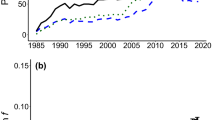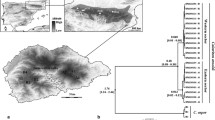Abstract
A major concern in conservation biology is toavoid inbreeding depression in smallpopulations. Inbreeding has been shown to causeloss of fecundity and reduced survival innatural populations. To predict futureinbreeding levels, given changes in ecologicalconditions, data from large outbred populationsare needed. I use recent population geneticmodels to show how genetic data from such apopulation, combined with ecological data canbe used to predict future changes in levels ofinbreeding. In particular, data from the lion(Panthera leo) is used to simulate theeffect of habitat loss on the future levels ofinbreeding. To do this I used a deterministicpopulation genetics models and anindividual-based stochastic model. Two factorsstand out as particularly important: totalnumber of prides and male dispersal rates. Ifprides are very few (= 10) inbreeding (F)will increase from 0.0 in the initial state to0.26–0.45 after 30 generations, while if thenumber of prides is 100 this level is onlyaround 0.05 assuming no migration into thepopulation. Habitat heterogeneity had onlyminor effects. A reduction in male dispersalfrom their natal territory from 100% to 95%increased the level of inbreedingsubstantially, and never reached below F≈ 0.25 regardless of the number ofprides. Therefore, to sustain a large outbredpopulation of lions, a continuous population ofat least 50 prides, but preferably 100 prides,with no limits to dispersal is required.
Similar content being viewed by others
References
Bijlsma R, Bundgard J, Boerema AC (2000) Does inbreeding affect the extinction risk of small populations?: predictions from Drosophila. J. Evol. Biol., 13, 502-514.
Brook BW, Tonkyn DW, O'Grady JJ, Frankham R (2002) Contribution of inbreeding to extinction risks in threatened species. Conserv. Ecol., 6, 16.
Burgman MA, Lamont BB (1992) A stochastic model for the viability of Banksia vuneata populations: environmental, demographic and genetic effects. J. Appl. Ecol., 29, 719-727.
Charlesworth D, Charlesworth B (1987) Inbreeding depression and its evolutionary consequences. Ann. Rev. Ecol. Syst., 18, 237-268.
Chesser RK, Rhodes Jr OE, Sugg DW, Schnabel A (1993) Effective sizes for subdivided populations. Genetics, 135, 1221-1232.
Cnrokrak P, Roff DA (1999) Inbreeding depression in the wild. Heredity, 83, 260-270.
Crow JF, Kimura M (1970) An Introduction to Population Genetic Theory. Harper &; Row, New York.
DeRose MA, Roff DA (1999) A comparison of inbreeding depression in life-history and morphological traits in animals. Evolution, 53, 1288-1292.
Dias PC (1996) Sources and sinks in population biology. Trends Ecol. Evol, 11, 326-330.
Dobson AP, Mace GM, Poole J, Brett RA (1992) Conservation biology: the ecology and genetics of endangered species. In Genes in Ecology (eds. Berry RJ, Crawford TJ, Hewitt GM), pp. 405-430. Balckwell, Oxford, UK.
Frankham R (1995a) Conservation genetics. Ann. Rev. Genet., 29, 305-327.
Frankham R (1995b) Inbreeding and extinction: a threshold effect. Conserv. Biol., 9, 792-799.
Frankham R, Ballou JD, Briscoe DA (2002) Introduction to Conservation Genetics. Cambridge University Press.
Greenwood PJ (1980) Mating systems, philopatry and dispersal in birds and mammals. Anim. Behav., 28, 1140-1162.
Hartl DL, Clark AG (1989) Principles of Population Genetics. Sinauer, Sunderland, MA.
Hedrick PW, Kalinowski ST (2000) Inbreeding depression in conservation biology. Ann. Rev. Ecol. Syst, 31, 139-162.
Lacy RC, Alaks G, Walsh A (1996) Hierarchical analysis of inbreeding depression in Peromyscus polionotus. Evolution, 50, 2187-2200.
Lacy RC, Ballou JD (1998) Effectiveness of selection in reducing the genetic load in populations of Peromyscus polionotus during generations of inbreeding. Evolution, 52, 900-909.
Lande R (1988) Genetics and demography in biological conservation. Science, 9, 782-791.
Loeschske V, Tomiuk J, Jain S (1994) Conservation Genetics. Birkhäuser, Basel.
Lynch M, Ritland K (1999) Estimation of pairwise relatedness with molecular markers. Genetics, 152, 584-599.
Mills LS, Smouse PE (1994) Demographic consequences of inbreeding in remnant populations. Amer. Nat., 144, 412-431.
Nieminen M, Singer MC, Fortelius W, Schöps K, Hanski I (2001) Experimental confirmation that inbreeding depression increases extinction risk in butterfly populations. Amer. Nat., 157, 237-244.
Oostermeijer JGB (2000) Population viability analysis of the rare Gentiana pneumonanthe: the importance of genetics, demographics and reproductive biology. In Genetics, Demography and Viability of Fragmented Populations (eds. Young AG, Clarke GM), pp. 313-334. Cambridge University Press, Cambridge, UK.
Packer C, Herbst L, Pusey AE, Bygott JD, Hanby JP, Cairns SJ, Borgerhoff Mulder M (1988) Reproductive success of lions. In: Reproductive Success (ed. Clutton-Brock TH), pp. 363-383. Chicago University Press, Chicago.
Packer, C, Gilbert DA, Pusey AE, O'Brien SJ (1991a) A molecular genetic analysis of kinship and cooperation in African lions. Nature, 351, 562-565.
Packer C, Pusey AE, Rowley H, Gilbert DA, Martenson J, O'Brien SJ (1991b) Case-study of a population bottleneck–lions of the Ngorogoro crater. Cons. Biol., 5, 219-230.
Pusey AE, Packer C (1987) The evolution of sex-biased dispersal in lions. Behaviour, 101, 275-310.
Rousset F (2002) Inbreeding and relatedness coefficients: what do they measure? Heredity, 88, 371-380.
Saccheri I, Kuussaari M, Kankare M, Vikman P, Fortelius W, Hanski I (1998) Inbreeding and extinction in a butterfly metapopulation. Nature, 392, 491-494.
Schaller GB (1972) The Serengeti Lion. University Chicago Press, Chicago.
Soulé ME (1987) Viable populations for conservation. Cambridge University Press, Cambridge.
Spong G, Creel C (2001) Deriving dispersal distances from genetic data. Proc. Roy. Soc. Lond., B268, 2571-2574.
Spong G, Creel S, Stone J, Björklund M (2002) Genetic structure of lions (Panthera leo L.) in the Selous Game Reserve: implications for the evolution of sociality. J. Evol. Biol., 15, 945-953.
Stone J, Björklund M (2001) DELRIOUS: a computer program designed to analyse molecular marker data and calculate delta and relatedness estimates with confidence. Mol. Ecol. Notes, 1, 209-212.
Wildt DE, Bush M, Goodrowe KL, Packer C, Pusey AE, Brown JL, Joslin P, O'Brien SJ (1987) Reproductive and genetic consequences of founding isolated lion populations. Nature, 329, 328-331.
Vucetich JA, Waite TA (1999) Erosion of Heterozygosity in Fluctuating Populations. Conserv. Biol., 13, 860-868.
Author information
Authors and Affiliations
Rights and permissions
About this article
Cite this article
Björklund, M. The risk of inbreeding due to habitat loss in the lion (Panthera leo). Conservation Genetics 4, 515–523 (2003). https://doi.org/10.1023/A:1024737317695
Issue Date:
DOI: https://doi.org/10.1023/A:1024737317695




